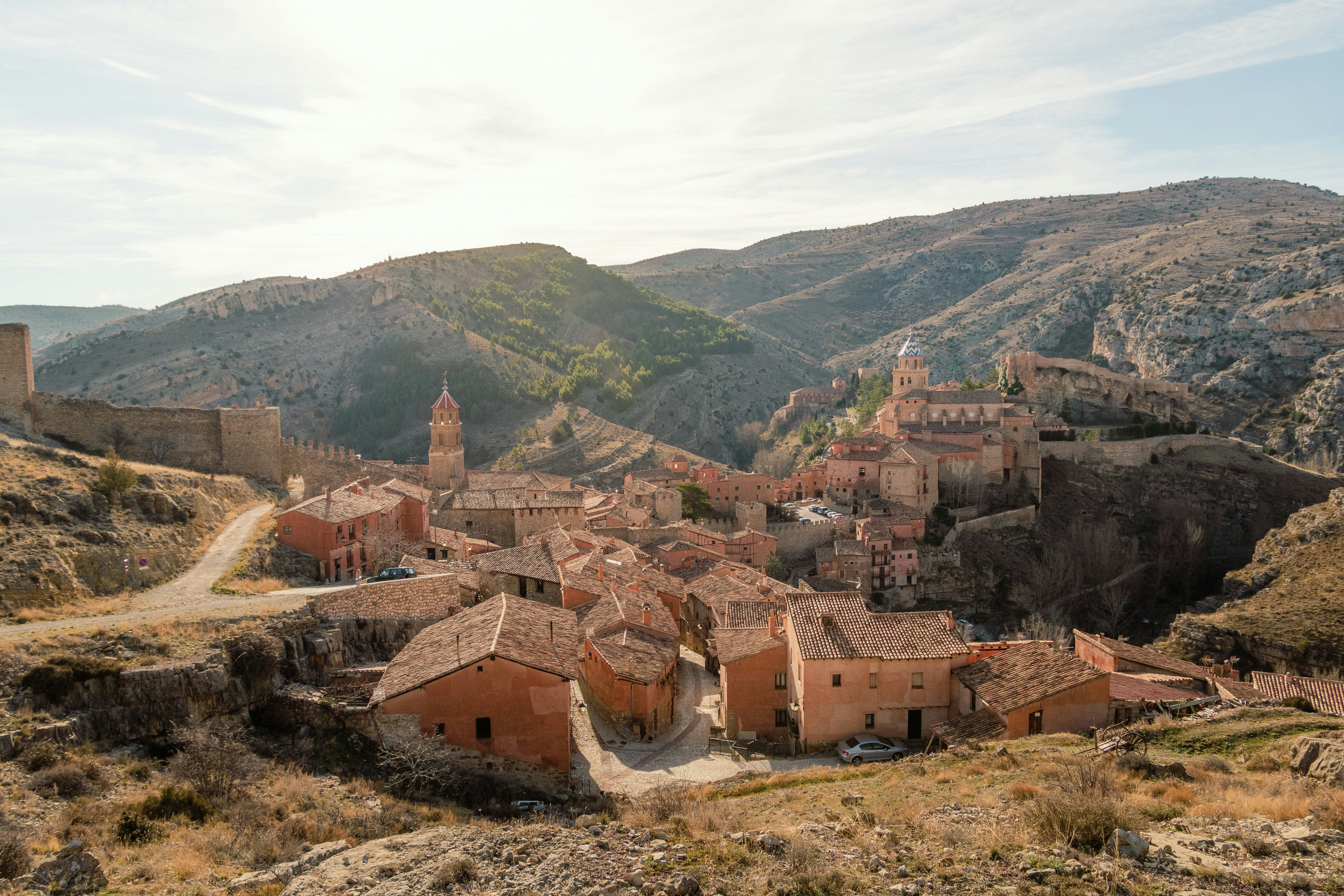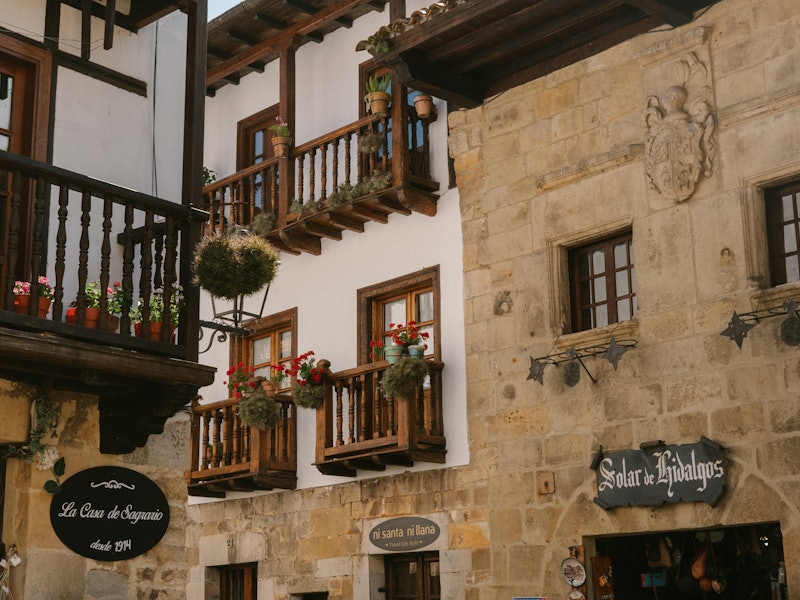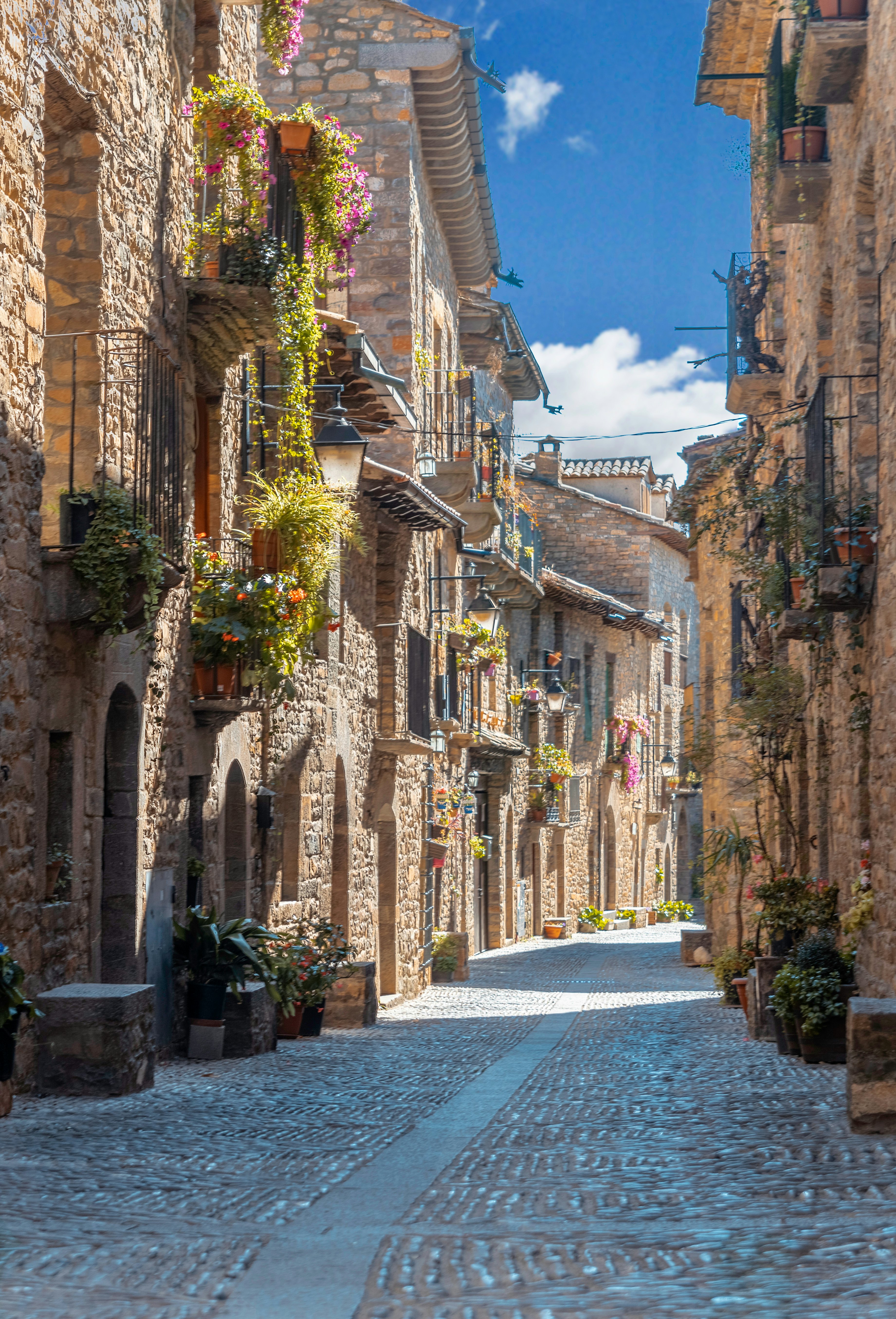From the blinding light, Moorish alleys and Mediterranean views of Andalucía’s pueblos blancos (white towns) to castle-topped medieval villages peering up to the Pyrenees, or the cliff-hugging, honey-toned hill towns of Mallorca to hamlets in the shadow of the cloud-grazing Mt Teide on Tenerife, Spain canters through every epoch and architectural style to deliver some of Europe’s most beautiful backdrops.
We’ve combed every inch of this lovely, feisty, sun-scorched land to bring you 12 of our absolute favorite villages in Spain.
1. Deià, Mallorca
Best village in low season
Mallorca’s Serra de Tramuntana mountains are sprinkled with pretty villages that send Instagrammers into raptures, but Deià, clinging to a hillside on the island’s northwest coast, is arguably the most gorgeous of the lot. Honey-hued, terracotta-tiled, bougainvillea-draped houses peek above palm and cypress trees. Hovering between the glittering blue Mediterranean and the thickly wooded mountains that ripple along the island’s northern spine, this village is set down in an Edenic setting of orchards, almond and olive groves, vegetable gardens and vineyards.
Deià’s beauty is no secret – whatever you do, avoid the peak summer crush if you want to tune in to the village’s romance as the former haunt of artistic souls like British poet Robert Graves. He built his dream home here in 1929, which you can now visit. Or you might be inspired to pen a verse of your own on the mountain-facing Poets’ Walk at Belmond La Residencia.
Planning tip: While you’re here, make the 10-minute drive to Son Marroig, a grand mansion once owned by Habsburg Archduke Ludwig Salvator. The gardens have sublime views out to sea. Ask for permission to walk the 3km (1.9-mile) path through olive groves and pine trees down to Sa Foradada, a bizarre hole in the rock that resembles an elephant from certain angles.
Advertisement

2. Albarracín, Aragón
Best village for Moorish history
Albarracín, in the mountainous reaches of Aragón in Spain’s east, is a knockout. Prettily perched 1182m (3877ft) above a loop in the Río Guadalaviar, it’s a vision in soft pink stone – never lovelier than when sunset makes the rugged cliffs and medieval half-timber houses blush. Back in the 10th century, the Moors left their stamp on the steeply climbing fortress walls (hike up them for soul-stirring views); the medina-like, shadowy alleyways; and the dominating castle. For the inside scoop on regional history, dip into the Museo de Albarracín.
But Albarracín’s real magic lies in kicking back and absorbing time-lost Spain over a tasting platter of local charcuterie and cheese (the cave-aged Albarracín sheep cheese is superb) and Aragonese wines at Alizia, just off the Plaza Mayor.
Planning tip: Pair a stay here with a visit to nearby Teruel, a UNESCO-stamped marvel of Mudéjar architecture, with 14th-century towers modeled on minarets, a staggeringly ornate cathedral and Fundación Amantes, complete with the mausoleum for the tragic amantes (lovers) Isabel and Juan Diego, the town’s very own Romeo and Juliet.

3. La Orotava, Tenerife
Best town for solo travelers
If you’ve got Tenerife down as merely a fly-and-flop package holiday, you’re missing out. In the shade of the cloud-wreathed volcano Mt Teide, Spain’s highest peak at 3715m (12,188ft), La Orotava catapults you back to the 16th-century in a tangle of streets and flower-dotted plazas. The atmosphere here is thoroughly Canarian – a refreshing contrast to resorts on the coast.
Get a feel for the place by ambling along the showstopping Calle San Francisco, where immaculately preserved mansions catch your eye with carved balconies. At the unmissable Casa de los Balcones, stop by the courtyard cafe to sip a coffee before heading to nearby Casa Lercaro, with its baroque wooden gallery.
It’s a great place to travel alone too. Check out La Orotava’s old-fashioned tascas (bars) for drinks and tapas, or buy hand-milled gofio (flour made from toasted grains) at the historic La Maquina mill. Go for a tasting after a vineyard tour (try Bodegas Tajinaste), then ask your way to a nearby guachinche (a small, simple family-run eatery) for a cheap-as-chips Canarian feast with local wine.
Planning tip: La Orotava is too good to rush. Dream about the town’s heritage in the beautifully converted 17th-century mansion that’s now Hotel Rural Victoria.


4. Santillana del Mar, Cantabria
Best town for medieval charisma and cave art
As the saying goes, Santillana del Mar in Cantabria in northern Spain is a town of three lies: it’s not holy (santi), flat (llana) or by the sea (del mar) – well, the latter is debatable, as it is only a wave away from the Atlantic coast. One thing is true, however: Santillana is a beauty. History is writ large in this well-preserved medieval time capsule, where cobblestone streets lead past 15th- to 18th-century houses of tanned stone and brick, with balconies festooned in flowers.
There are sights to hold you for a spell, including the 12th-century monastery Colegiata de Santa Juliana and its striking Romanesque cloister, but you’ll soon be itching to head out of town to visit the Museo de Altamira. The stunning recreation of the Cueva de Altamira’s Polychrome Hall chamber captivates with bison paintings made using the natural rock relief.
Planning tip: For a true flavor of Santillana del Mar, stay overnight in one of the lovingly restored posadas (historic guesthouses), such as the revamped medieval Santa Juliana.

5. Malpartida de Cáceres, Extremadura
Best town for slowing down
Advertisement
In Spain’s wild western region of Extremadura, nudging the Portuguese border, time slows and history is deeply etched into the crumbling walls of medieval cities, villages and hamlets. One of the fairest of all is the whitewashed, terracotta-roofed town of Malpartida de Cáceres, famous for its sizeable stork colony.
Once you’ve had a jaunt around town, you’ll be drawn to nearby Los Barruecos, a natural monument of bizarrely shaped granite boulders, sculpted over millennia and reflected in reservoir waters. These fantasy landscapes starred in battle scenes in Game of Thrones.
Planning tip: From May to September, the Plaza Mayor is at its photogenic best, shaded by more than a thousand brightly colored parasols. Admire them over drinks and tapas from the terrace of LosPuri 1978.

6. Vejer de la Frontera, Andalucía
Best village for history
Ask a local to divulge Andalucía’s loveliest village – no mean feat as the competition is stiff – and Vejer de la Frontera invariably makes the list. With its bone-white houses stepping down a rocky hillside and piercing blue skies, the town looks as though it was plucked from a cubist painting. Beyond, orchards and olive groves spill onto the sandy beaches of the Costa de la Luz.
Kick off any visit with a romp around the historic center: the striking 15th-century walls, gateways and former judería (Jewish quarter); the Moorish castle, with its original rainwater aljibe (cistern); and the palm-fringed, cafe-rimmed Plaza de España, with its Seville-tiled fountain. Round out with dinner at El Muro, where chefs riff imaginatively on the freshest seasonal ingredients.
Planning tip: May, June and September are terrific months for dodging the biggest summer crowds but still catching fine weather at surf-smashed beaches like El Palmar.

7. Medinaceli, Castilla y León
Best town for Roman ruins
You could roam the vast plains and mountains of Castilla y León in Spain’s north forever and not find a prettier pueblo than Medinaceli. Strung along a ridge 1204m (3950ft) above sea level, this dinky hill town seduces with its mix of Roman ruins, quiet alleys and warm stone houses that recall the families who lived here when the village was captured during the Christian Reconquista of 1124.
If you’re up for a historic deep dive, top billing goes to the Arco Romano, the Roman triumphal arch that’s one of Spain’s best preserved; the Puerta Árabe, one of the four original gates to the Roman settlement, with dreamy views over rolling countryside to boot; and the Roman mosaic on display in the 17th-century Palacio Ducal, which crowns the colonnaded Plaza Mayor.
Planning tip: Can’t choose between city and hill town? Medinaceli is just a two-hour train ride or drive from the capital, Madrid, so you can easily combine both.


8. Frigiliana, Andalucía
Best village for pueblo blanco charm
On a day when the summer sun burns in flawless Andalucian skies, the pueblo blanco of Frigiliana is so dazzlingly white that you’re forced to shield your eyes from the glare. Slung high above the sea on the slopes of the Sierra Almijara, the town is a jigsaw of Moorish alleys, with blue doors, brick arches and shocks of floral color. For an unbeatable panorama over the village, to the mountains and out to the bright blue sea, clamber up to the highest point, the medieval ruins of the Moorish Castillo de Lízar. Get an early start to beat the heat. As you wander through the village’s mazy heart, keep an eye out for 12 ceramic panels recounting local history.
Frigiliana is terrifically placed for exploring the wider region. Alternate time spent here with lazy beach days on the Costa del Sol. The golden sand coves, crystal blue waters and cathedral-like caves of Nerja are just 8km (5 miles) down the road. Granada, with its mighty Alhambra, and the snow-tipped peaks of the Parque Nacional de Sierra Nevada are also just an hour away.
Planning tip: Frigiliana is less than an hour’s drive east of Málaga, meaning you can easily combine a trip here with a visit to the soulful city where Picasso grew up.

9. Aínsa, Aragón
Best town for hikes in the Pyrenees
You can tick off medieval towns and Crusader castles like rosary beads as you wend through the rocky hills of Huesca province in northern Aragón, but few can hold a candle to insanely lovely Aínsa, a beauty with entrancing views of the Pyrenees. The mountains whoosh above its golden stone houses, cobblestone streets and plant-bedecked alleys, eliciting little gasps of wonder from first-time visitors. And you won’t be able to take your eyes off the buttress-like 2295m (7529ft) crag of Peña Montañesa soaring above town.
Start at the Plaza Mayor, a gracious square rimmed by arcades, then swing over to the Castillo for mesmerizing vistas from the ramparts. The town is also a fabulous springboard for hikes in the sky-scraping peaks of the Pyrenees in the 156-sq-km (60-sq-mile) Parque Nacional de Ordesa y Monte Perdido, a 20-minute drive north.
Planning tip: Dodge the busier summer months to really feel the magic and bring walking gear for high-level mountain hikes.

10. Begur, Catalonia
Best town for Modernist architecture
Capped off by the eye-catching ruins of its medieval castle, plonked high on a wooded crest, and with views over rolling hills to the brilliant blue sea, Begur, on Catalonia’s Costa Brava, is an instant heart stealer. First, you’ll want to hoof it up the 1km (0.6-mile) track to the castle, which looks much as it did when it was destroyed by Spanish troops to stop Napoleon’s advancing army in 1810. Film-set worthy? You bet. The film Suddenly, Last Summer, starring Elizabeth Taylor, was shot at the castle in 1959.
Beyond this, you can spend a sun-drenched morning wandering through lanes stacked with Modernista mansions like Casa Vicenç Ferrer Bataller, stopping for a seasonal lunch or, later, predinner cocktails in the garden of the Cuban-style mansion Aiguaclara. Many such neoclassical mansions were built on the riches of the 19th-century tobacco, flour and cork trade with the West Indies.
Planning tip: Pack for the beach, too, as roads from here corkscrew down to some of the Costa Brava’s dreamiest coves, such as Cala d’Aiguafreda, Cala de sa Tuna and Sa Rieira.

11. Valldemossa, Mallorca
Best village for classical music
The ragged, thickly wooded slopes of the Serra de Tramuntana range rise like a natural amphitheater above the improbably pretty village of Valldemossa on Mallorca’s north coast. If you have the good sense to avoid the peak summer months, you will find a lot to love about its tan stone alleys. Gazing out above terraced hillsides, the village is less about ticking off sights and more about soaking up the vibe from a cafe like Orígenes.
There is one exception to this rule: the Real Cartuja, a grand Carthusian monastery that was home to kings, monks and 19th-century composer and legendary pianist Frédéric Chopin and his partner, the French novelist George Sand. The pair spent the winter of 1838 here. Entry includes hourly piano recitals.
Planning tip: Get your timing right to catch the Pianino Festival, which kicks off in March and runs through summer. Performances of Chopin’s works (some on his original piano) are held in the Real Cartuja.

12. Calatañazor, Castilla y León
Best village for switching off
A cat’s cradle of uneven lanes and rough brick-and-timber medieval houses topped off with conical chimneys, the hilltop Calatañazor in Castilla y León fits the romantic Spanish village bill perfectly. That’s if you can even call it a village. With a population of just 43, this dinky hamlet was the backdrop for Orson Welles’ 1965 tragicomic drama Chimes at Midnight and the 1965 romance Doctor Zhivago.
For stirring views from walls and watchtowers, make a beeline for the one and only sight: Castillo de Calatañazor, a ruined Muslim fortress. That done, you might want to strike out into the surrounding countryside. A half-hour drive west brings you to the Parque Natural Cañón del Río Lobos, a dramatic limestone canyon where you can hike in forests of juniper and pine and spot birdlife like griffon vultures, golden eagles and falcons.
Planning tip: Experience Calatañazor at its silent best after the day-trippers have departed by staying the night in one of its historic casas rurales (rural homes).

